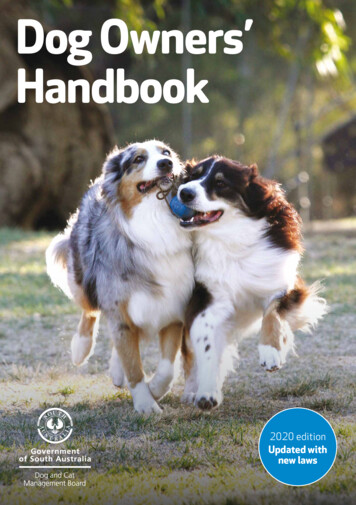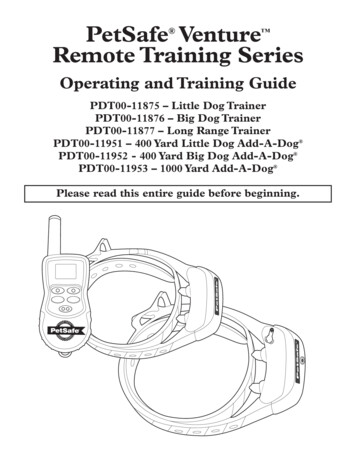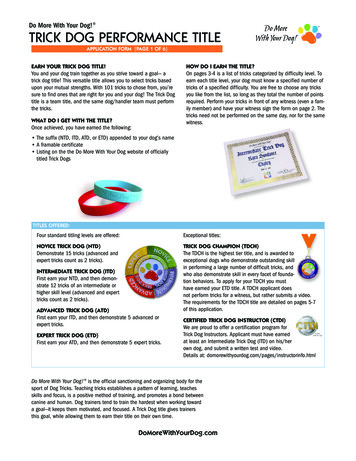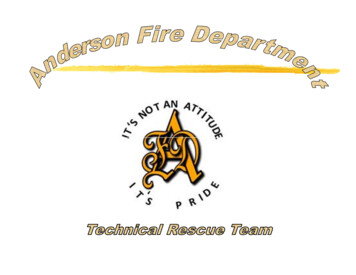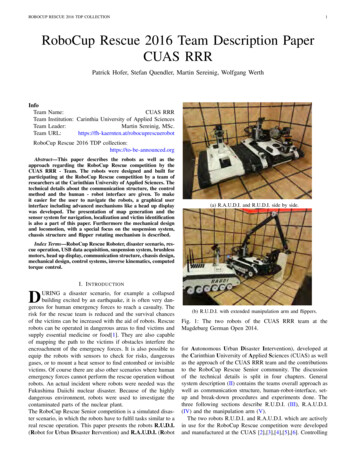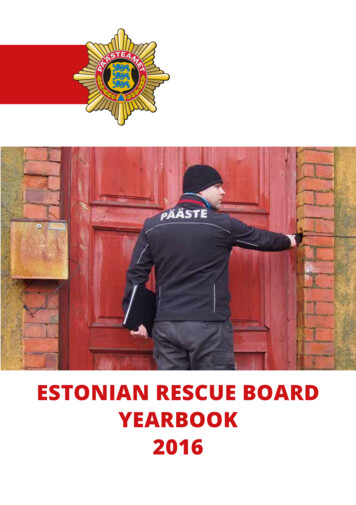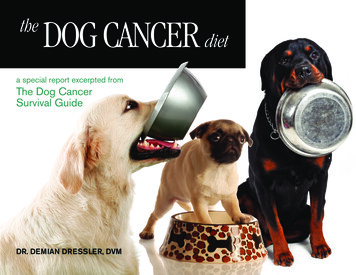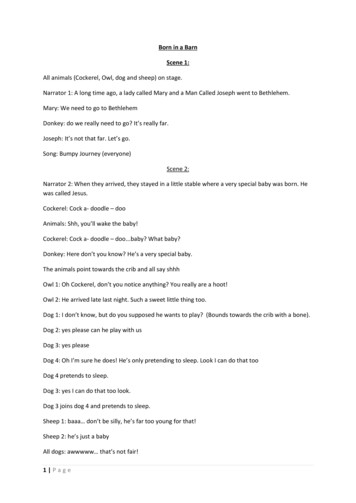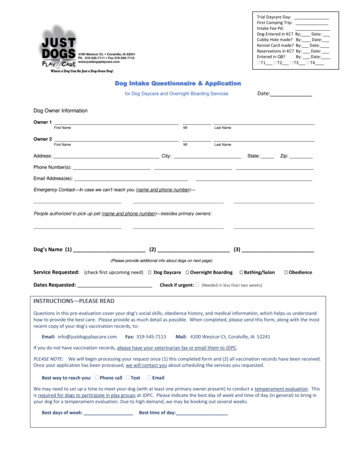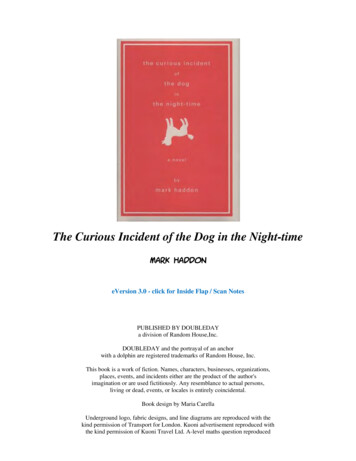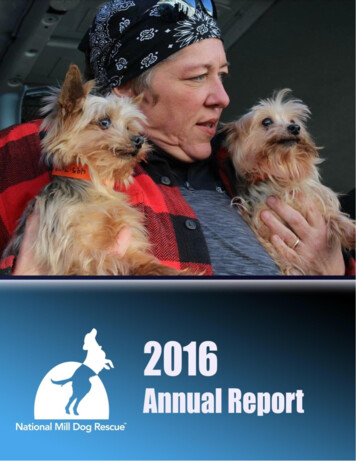
Transcription
National Mill Dog Rescue2016 Annual ReportFrom ourFOUNDERDear friends,As 2016 drew to a close, therealization hit that the 10thanniversary of Lily’s rescue wasjust a few weeks away. What ajourney the last decade has beenfor all of us! Incredible highs, devastating lows, and everything in between, but eachexperience continues to be deeply rewarding. At the end of a decade of work, eachand every day our focus remains the same—it’s about the dogs. That said, 2016 wasa year of reflection—looking back across nearly a decade rescuing dogs, almost12,000 of them! Remembering so many faces, so many stories of healing andredemption. Although the core of our mission remains unchanged, throughout 2016we worked on strengthening the organizational framework for the future of NationalMill Dog Rescue.Across the year, we rescued 938 dogs and set new goals for several of our programs,including a restructuring of the Adoptions Department. We strengthened ourrelationships with transfer partners and added new ones, and we examined strategiesfor taking our marketing and social media efforts to the next level.While we had slightly fewer adoptions than the previous year, the population of dogsthat are being surrendered to us have more complex health and behavioral issues thatneed to be addressed prior to placing them into permanent homes. The number ofcommercial breeders continues to dwindle; and while that is good news, many ofthose who release their dogs to us are turning over dogs that are older and have fargreater medical needs.Our volunteer base continues to be strong and is the life blood of the day-to-day workthat keeps our organization growing and strong. My gratitude to our volunteers is trulyimmeasurable, as not only have they helped make my dream come true, but withoutthem, thousands of dogs would have never enjoyed their final years as cherishedfamily members.Last, but certainly not least, our supporters are vital to our success.
National Mill Dog Rescue2016 Annual ReportWithout you, what we do would not be possible. By the year’s end, we had saved11,800 dogs; and, quite honestly, we could not have done it without the unwaveringsupport and encouragement of each and every one of you.The eyes of these survivors reflect the gratitude that wefeel every day for being able to give them the lives theyso richly deserve. We are blessed to witness miracles,as the most broken among them transform into the dogsthey were always meant to be. These precious souls areoften terrified and confused when they are rescued fromthe confines of their wire cages, the only lives they haveever known. With love, medical care and time, each dogwe rescue teaches us great lessons in forgiveness andresilience. From the moment the dogs are in our arms,experiencing their first moments of freedom, to the daythey go to their forever homes, our hearts are filled withjoy.In closing, as we prepare for a new year andnew challenges, one thought stands out. Weare the lucky ones. It is our honor, our prideand our joy to be able to guide these dogs ontheir journey to freedom.With love and gratitude,Theresa StraderExecutive Director
National Mill Dog Rescue2016 Annual ReportMission STATEMENTTo rescue, rehabilitate and rehome discarded breeding dogs and to educate thegeneral public about the cruel realities of the commercial dog breeding industry.National Mill Dog Rescue is a 501 (c)(3) nonprofit organization located in Peyton,Colorado.Our Humble BEGINNINGSNational Mill Dog Rescue (NMDR) started with a one-sentence email plea for helpwith a large number of dogs in need.Over the subsequent decade, it hasgrown into a mission that has savedwell over 11,000 dogs.In February 2007, Theresa Straderreceived a brief email soliciting help for“Fifty Italian Greyhounds in need.”Twenty-five years of rescue work,coupled with a lifelong love of thebreed, compelled her to offer herassistance. She then learned that alarge commercial dog breeding facility,a puppy mill, was going out ofbusiness. The breeder would beauctioning off her entire kennel, 561dogs; 49 were Italian Greyhounds.Three days later, Theresa loaded up her van, and, along with her teenage daughter,made the 750-mile journey to the auction site in Missouri. With nothing more than thedesire to help dogs in need, they had no idea what to expect.After registering for their auction number, Theresa and her daughter entered the first ofseveral buildings that housed the dogs. Within moments of entering the building,overwhelmed by the scene of hundreds of dogs frantically pacing in small wire cages,breathing in the stench of the filth the dogs were forced to live in and witnessing thefear and desperation in their eyes, Theresa knew she would spend the rest of her lifebringing a voice to the dogs held captive by this shameful industry.
National Mill Dog Rescue2016 Annual Report“I will love you ‘til you die . . .”It was in the secondbuilding that Theresawould first lay eyes on#251 . . . a fragile, 7-yearold Italian Greyhound,huddled in the back of hercage. Taking a closerlook, she could see andfeel the years of neglectthis little dog hadsuffered. Her face wastwisted and deformed, herlower jaw had rottedaway. She was thin andtrembling in fear.As #251 looked into her eyes, Theresa whispered into her cage: “I’m gonna take youfrom this hell and love you ‘til you die.” Theresa made that promise on February 17,2007, and in that moment National Mill Dog Rescue was born.Theresa and herdaughter came homewith 13 dogs, far morethan they hadanticipated. WhatTheresa also camehome with was aburning desire to tellthe truth about thereality behind petstore and internetpuppies. She got rightto work, building hermission, filing fornonprofit status; and she began to educate far and wide. People listened, andvolunteers began coming to her home to help care for the dogs. NMDR was on its feet!
National Mill Dog Rescue2016 Annual ReportWho WE ARENational Mill Dog Rescue is known and respected around the globe for its work inrescuing puppy mill survivors. We are aregistered 501(c)3 organization and rely ondonations to continue rescuing more dogsfrom the confines of their wire cages.National Mill Dog Rescue, or NMDR, wasstarted in the backyard of Theresa Strader’shome in February 2007. In the years thatfollowed, it has grown into an organizationthat is known around the world. NMDRemploys 22 people and is grateful for thedevoted work of hundreds of volunteers tohandle the day-to-day operations.As we close in on another landmark, 12,000 dogs rescued, we never stray from thefounding missionstatement: It’s about thedogs. We will celebratethe 10th anniversary ofLily’s rescue on Feb. 17,2017. It is in her memorythat thousands of dogswill get the love, medicalcare, and, ultimately, thehomes they so richlydeserve.It is our goal to increaseour financial resources,so that we can continueto provide top-notch carefor these dogs that wereneglected and used as“breeding machines,”while we aid them in every aspect along their journey to freedom.
2016SUMMARYRescue Statistics3 rescue vans60 or more dogs rescued per tripFrequency of trips: At least one per monthAverage cost of rescue mission: 2500/trip938 dogs rescued756 dogs brought to our kennelAdoptions Program606 dogs adoptedAverage # of Adoptions per month: 50Average time from arrival to adoption: 86days100 dogs living at the kennelApproximately 100 dogs living in foster careVeterinary Care & RehabilitationAverage cost per dog for basic care: 300Dogs needing extensive dentals: approximately 50%Costs for specialty care: 10,000 per month475 spay/neuter surgeriesAverage number of dogs in rehab program: 13700 lbs. of dog food used monthlyEducation & OutreachAdoption Fairs: 18Community Programs: 44Groups Volunteering: 2 per monthVolunteers95 percent volunteer-based589 people registered19,898 hours recorded177 foster homeSocial Media PlatformsFacebookTwitterInstagramYouTube
National Mill Dog Rescue2016 Annual ReportDog Rescue AND CARERescueA typical rescue trip involves a two- to three-day journey covering 1,500 to 2,500 milesacross several states. Our rescue teams keep the dogs safe and comfortable during thejourney home and are able to provide basic medical care when necessary.Occasionally, there will be an emergency stop at a veterinary clinic if a dog needsmore skilled attention.IntakeOur rescue teams begin assigningnumbers for intake and collaring thedogs while still on the road. When theteams arrive back at Lily’s Haven, ouroffloading team is ready to welcomethe new arrivals. The dogs are placedin kennel runs with nutritious food,fresh water, a bed and a blanket. Formany, these basic comforts are all“firsts” that these dogs have beendenied for their entire lives.Any dogs requiring immediateveterinary care are transported toPowers Pet Emergency and Specialtyin Colorado Springs.
National Mill Dog Rescue2016 Annual ReportThe newcomers are given time to acclimate totheir new surroundings before completing theintake process. We typically wait a day or two,and then our intake team takes them throughvarious stations. The dogs are dewormed andheartwormtested.Finally, our grooming team works magic with our newresidents. Their “spa day” washes away what is oftenyears of filth, and their true beauty begins to emerge!In the days that follow, the veterinary team performs spay/neuter surgery,microchipping, treatment for severe dental disease and a multitude of other necessaryprocedures.RehabilitationProgramNational Mill Dog Rescue isfortunate to have anexceptional rehabilitationteam of volunteers who workwith our most troubled dogs.These dogs are tootraumatized to be ready foradoption when they arrive at ourkennel. Our tireless volunteers workwith each dog on his or her individualissues until the dogs learn to trust andrealize that we are not going to hurtthem.The process starts at intake, whenred, yellow, or green cards are put onthe dogs’ paperwork to indicate how
National Mill Dog Rescue2016 Annual Reportstressed they are. Agreen dog is moresocial and can behandled by anyvolunteer. Yellow dogsare timid and will onlybe approached byexperiencedvolunteers. Red dogscan only be handled byselect members of therehabilitation team whoare trained in specialtechniques for workingwith very fearful dogs.This system hasgreatly reduced thenumber of dogs who are labeled as biters, because their temperaments are taken intoaccount, and the scared dogs are handled more carefully.The dogs are given a week to settle into their new environment before they areevaluated for rehabilitation. If a dog is placed in the rehab program, three or fourrehab team members are assigned to work with that dog. An assessment iscompleted, and a treatment plan is developed. Many dogs on rehab are fear biters.
National Mill Dog Rescue2016 Annual ReportSome walk well on a leash, and others resist. Many are afraid of being touched or pickedup, because they’ve never experienced gentle touches in their lifetime. The rehab teammeets once a month to assess the progress of each dog and make adjustments to therehabilitation plan.Very often, the process of workingwith an individual dog begins with arehab team member simply enteringthe enclosure, sitting quietly, andpossibly tossing treats in the dog’sdirection without making eye contact.In the dogs’ prior experience, anytime someone approached them,they were treated roughly or actuallyhurt, so the first thing they learn isthat the mere presence of a humanbeing is not threatening. The timeframe for this trust-building varieswidely with each dog. Once trust hasbeen established, the volunteer willmove on to such things as offering a treat to the dog to take from his or her hand,gently touching the dog, picking up and carrying the dog, and introducing the leash.Walking on a leash is a requirement forgraduating from the rehab program.A sensory enrichment program is oftenimplemented using essential oils,aromatherapy and other olfactory stimulisuch as frozen baby food.Desensitization to common sounds,including the grooming room, andlistening to soothing music or a cuddlingin a rocking chair are used for calming.Before dogs are taken off rehab, theyare exposed to many different volunteers to make sure they are comfortable with allpeople and not just the few they have learned to trust. The most rewarding part of therehab team’s job is to see the dogs who once would bite or otherwise avoid allhuman contact, now happy in a home and acting just like any other dog.
NatioVeterinary Care ProgramWe are committedto taking care of allthe dogs who arereleased to us, nomatter how sick orhow old. The dogsarrive with manymedical concerns.These includesevere dentaldisease, eye, ear,uterine and skininfections,neurological andcardiac conditions,orthopedic problems, cancer and genetic deformities. Some dogs are blindor deaf and some are psychologically damaged from years of confinement.We have two highly skilled veterinarians on staff, Dr. Traci Duncanson and Dr.Debbie St. Louis. They are assisted by our outstanding support staff ofveterinary technicians and assistants. This team provides the complex medicalcare and attention required to facilitate healing.Each dog receives a comprehensive medical exam, and a treatment plan isdeveloped. Some are referred to specialists in the community, and all areprovided with pain management to assure maximum comfort as theyundergo life- saving procedures.AdoptionsOur adopters come from allover the country to adopt ourspecial population of dogs.Education is at the forefront ofour adoptions process. Whilemost adopters have heard ofpuppy mills, most do not
National Mill Dog Rescue2016 Annual Reportrealize all that it entails to actually welcome a puppy mill survivor into their home. Afterwe receive an adoption application, each applicant participates in a phone interviewwith an adoptions counselor. It is at this time that we ensure that applicants areproperly educated on our dogs, and we take time to answer any questions orconcerns.After the phone interview, approved adopters areinvited to visit the kennel. We consider our staff to be“matchmakers,” and we go to great lengths to ensurethat adopters leave with the best fit for their specificlifestyle.Once a dog is in his or her forever home, we offerpost-adoption support. A volunteer team memberdoes a follow-up phone call on every adoption. If thedog or adoptive family is having a difficult timetransitioning, we offer advice and continue to stay intouch until any problems are resolved. Our rehabteam leader occasionally makes house calls to help.our most difficult cases.Post-adoption behavior supportFor six months following an adoption, we offerfree and expert guidance to help the adoptersunderstand and correct behaviors that arecommon with mill dogs. A Facebook groupcalled “From Puppy Mill to Pet” gives support tomill-dog adopters across the country. The pagealso offers members a platform to interact witheach other about their experiences adopting apuppy mill survivor.Post-adoption lost dog supportYears of confinement and a lack of socialization leave many of ourdogs fearful and potential flight risks. Our lost dogs team is madeup of some of our most deeply committed volunteers, ready tomobilize on a moment’s notice. They search for the dog andimmediately mass-produce and distribute informational flyers onsocial media and throughout neighborhoods.
National Mill Dog Rescue2016 Annual ReportIn 2016 our lost dogs team responded to 18 reported lost dogs. Fifteen of the dogs weresuccessfully recovered.Among those recovered was Foxey a small, long-hairedChihuahua. She went missing in Woodland Park, in themiddle of a late winter storm. Volunteers drove throughblizzard conditions on dangerous mountain roads to searchfor this little one. Humane traps were set and checked daily.Miraculously, after eight days in the Colorado wilderness,this tiny Chihuahua was found walking down a mountain roadat night. The good Samaritans had seen posters thatvolunteers had hung up and knew who to call. Thankfully,Foxey was uninjured and returned to her grateful family.Education & OutreachThe education and outreach team embodies the second part of National Mill DogRescue’s mission: to educate thegeneral public about the cruelrealities of the commercial dogbreeding industry. They presentinformation to schools that raisefunds for NMDR, YMCA daycamps, library groups, andanyone who is interested inhearing about puppy mills andadopting instead of buying from apet store or on the internet. Manytimes, adopted puppy millsurvivors accompany thevolunteers and share their storieswith the audience, much to the delight of children and adults alike.The team also supports NMDRfundraisers, such as “Dining for theDogs,” with informational brochures andadopted or foster dogs, when permitted.These events are also a great opportunityto reach people who otherwise would notlearn about puppy mills. Througheducation, we can make a difference inthe future of the puppy mill industry.
National Mill Dog Rescue2016 Annual Report.Fundraising EVENTSDog Jog 2016Our annual DOG JOG 5K FUNDRAISER took place inAugust at Cottonwood Creek Park. This family-friendlyjog/walk featured five contests, music, food andcostumes.There were 24sponsors, 349participants, 32vendors in the expoand 100 volunteers who made this event a hugesuccess.Dog Jog 2016 raised over 16,000.00!Little River Band Benefit ConcertThe Little River Band performed afantastic concert on our property inPeyton in August. We rolled in a stageand prepared a field area for concertgoers to spread out with lawn chairs,blankets and picnics. For more than twohours we enjoyed the band’s excellentmusic and took pictures with the band.Concert-goers were invited to tour thekennel and meet the dogs.This event raised over 17,000“Believe” GalaOur annual gala was held at the Wedgewood Inn in Black Forest in October. This event wasemceed by meteorologist Rachael Plath. Guests watched a moving presentation byTheresa and viewed a video highlighting the NMDR mission and dogs rescued over the lastnine years. There was a dog meet-and-greet area, and all enjoyed a delicious dinner. Thesilent and live auctions had great items and the bidding continued throughout the evening.This event raised over 26,000.
National Mill Dog Rescue2016 Annual ReportFinancial INFORMATIONCompassionate individuals who care about our mission make up more than 50percent of our donor base. They range from a handful who have the means tosupport us generously to those who can only drop spare change in a canister. Weare incredibly grateful for ALL levels of support!
National Mill Dog Rescue2016 Annual ReportBoard of DIRECTORSChairman: Chris ThorntonVice Chairwoman: Dee RuppertTreasurer: Richard StraderSecretary: Helen FreemanOther Members: Ron McClellandCharles Arnold
National Mill Dog Rescue 2016 Annual Report Mission STATEMENT To rescue, rehabilitate and rehome discarded breeding dogs and to educate the general public about the cruel realities of the commercial dog breeding industry. National Mill Dog Rescue is a 501 (c)(3) nonprofit organization located in Peyton, Colorado. Our Humble BEGINNINGS
